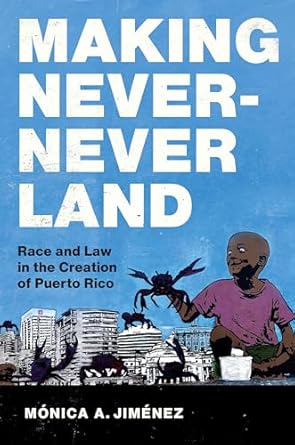The Book
Making Never-Never Land: Race and Law in the Creation of Puerto Rico
The Author(s)
Mónica A. Jiménez

Mónica A. Jiménez’s Making Never-Never Land: Race and Law in the Creation of Puerto Rico, offers a legal history of Puerto Rico’s colonial relation with the United States (US). The book further attempts to connect Puerto Rico’s colonial status with a history of racist Supreme Court decisions beginning with Johnson v. M’Intosh and ending with US v. Vaello Madero. Although the book offers a comprehensive summary of the Insular Cases, its strongest argument comes in its last chapter when Jiménez discusses the cases that lead up to the eventual passage of the Puerto Rico Oversight, Management, and Economic Stability Act (PROMESA).
Focusing mostly on the early 20th-century legal case that culminated in the creation of Puerto Rico’s current political status, the “Free Associated State” or “Estado Libre Asociado,” the book argues that Puerto Rico’s colonial status stems from the US’s denial to deal with its racist legal history. The first chapters of the book work to combine legal discussions of the Insular Cases (Puerto Rican Law) with a much-studied academic historiography of the Marshall Trilogy (Native American Law), and Dred Scott v. Sandford (African American Law). Particularly in relation to the Insular Cases, the book offers an accessible (in English) and comprehensive analysis of arguments previously held in Puerto Rico among Spanish-speaking scholars. Jiménez’s analysis also allows legal scholars of the Insular Cases to join discussions related to Native American Law.
I find that the book’s greatest contribution is its final chapter and, in it, its discussion of what she calls “The Death of the Estado Libre Asociado” or the 21st-century cases that brought back to the forefront Puerto Rico’s colonial status after the island declared it could not pay its debts. As Jiménez aptly asserts, the 21st-century legal pillars that give legitimacy to the Financial Oversight and Management Board show that “the Supreme Court, when presented with the opportunity to overturn Downes and state emphatically that the Insular Cases’ foundation in racism gave them ‘no place in law under the Constitution,’ declined to do so” (133). That is, the book shows that the US has had chances to deal with its colonial problem but has purposely declined to do so.
As a whole, Making Never-Never Land attempts to explain how the US’s inability to confront its racist legal past has meant that it currently continues to use blatant racism as legal precedent, especially concerning Puerto Rico, its political status, and its residents’ limited Constitutional rights (i.e. Second-Class Citizenship). Overall, Jiménez makes a good contribution to the seemingly never-ending discussion of what exactly is Puerto Rico’s political relation to the US, and what exactly are Puerto Ricans’ legal rights under the US Constitution.
About the Reviewer
Naida García-Crespo is an independent researcher with a PhD in English from the University of Illinois in Urbana Champaign. Her work has appeared in Film History, Early Popular Visual Culture, and CENTRO Journal, among other journals and essay collections. She is the author of Early Puerto Rican Cinema and Nation Building (1897-1940): National Sentiments, Transnational Realities (Bucknell University Press, 2019).

0